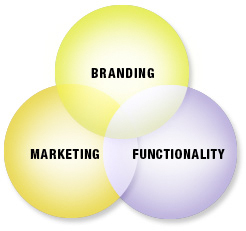The 3 Parts of a Healthy Website System
Ready to boost your SEO ?

The 3 Parts of a Healthy Website System
There are many ways to view websites, Internet marketing and the different components that comprise the online marketing ‘cloud’. Over the years, I’ve come to see that what we do for clients i.e. design and develop websites, is comprised of 3 parts; branding, marketing and functionality. And for a website to function properly, all 3 parts not only need to be implemented effectively, but also need to integrate well together. This is no small task and is rarely done well.
Part 1 - Branding
Branding on the Internet is an amorphous term that contains many parts, such as: a logo, tag line, user interface [look + feel], messaging [headline copy], text, photos, graphics, video, illustrations, motion graphics, demos, information architecture, interactivity etc. All of which fall under the term the ‘User Experience’.
This constitutes what is said, to whom and why it is said. Without the right message, to the right people, websites fail to meet their most basic task – communicate effectively to the target audience.
Typically the website branding + user experience suffers because it is under too much pressure to serve too many interests. The ‘more is more’ rationale typically wins out. The best interfaces often are the ones where the content comprises the majority of the page and the ‘look + feel’ is secondary, minimal and simplified.
Part 2 – Marketing
The marketing component of a website is even more amorphous than branding, since it’s evolving and expanding into something very different than what marketing was originally conceived to be. So new terms have arisen such as ‘demand generation’, ‘inbound marketing systems’, ‘viral marketing’ and ‘search marketing’ as well as many new terms such as SEO, SEM, black hat techniques, landing pages, doorway pages, sales funnels, link farms, favicons, bounce rates, keyword density, link rot, CPA, CPC, PPC, meta tag generator, Twitter, Flickr, digg, del.icio.us and the list goes on and on.
Nonetheless, the most common types of Internet marketing programs are: e-mail marketing, search marketing, pay-per-click advertising and analytics/measurement.
Regardless of the shifting sands of online marketing terminology and processes, websites suffer if at least some of these programs are not effectively used. They suffer in many ways, mostly from reduced traffic and decreased visibility on the Internet.
Part 3 – Functionality
Functionality here means how well a website works. Are there errors? Can you find what you are looking for? Is it easy to add pages, edit pages or add photos? How about self generated content or blogs or forums – does your technology platform include easy to add functionality? Is it software that has regular releases so that new functionality can be added or is it a stand alone pile of static code edited via FTP and a hard to reach web master located somewhere unknown?
There are many other parts to this as well such as technical problems with content that requires plug-ins such as video, audio, PDFs and other assorted file types.
Web 2.0 sites are typically built with software platforms such as Drupal, SalesForce.com and Websphere that enable advanced marketing, sales and content management features.
The key point to understand is that websites that are hard to use and hard to update and lack interactivity, are problems not only in of themselves, but also adversely affect the branding and marketing components of websites.
For example, the easier it is to manage site content [e.g. create/edit a page in-house] the more pages will comprise a website, this in turn makes the site more visible to the search engines, which results in a higher page rank, which results in more traffic and hopefully increased leads and sales.
Bottom Line
It’s a cliché but the whole is really greater than the sum of its parts, especially with websites. Understanding the different components and how best they integrate, is the first step to effectively realizing the value of a healthy website system.
To learn more about how healthy your website is, try the eValuator, a tool that quickly gauges the health of a website based on different indicators, such as search engine rankings, marketing components, technical issues, and analytics to name a few.
with a Booster program for Healthcare companies.

